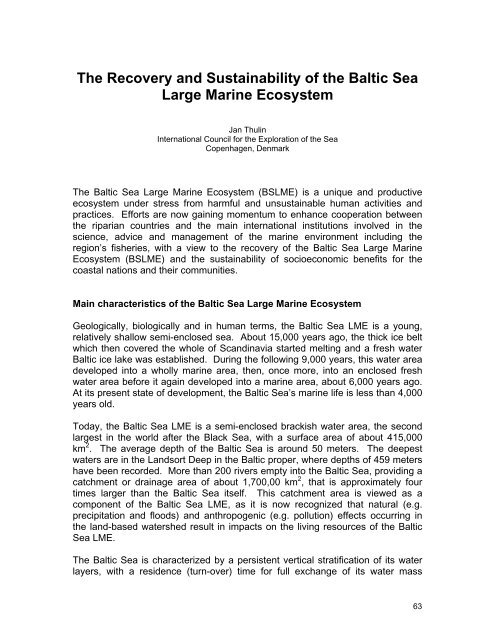Sustaining the World's Large Marine Ecosystems
Sustaining the World's Large Marine Ecosystems
Sustaining the World's Large Marine Ecosystems
You also want an ePaper? Increase the reach of your titles
YUMPU automatically turns print PDFs into web optimized ePapers that Google loves.
The Recovery and Sustainability of <strong>the</strong> Baltic Sea<br />
<strong>Large</strong> <strong>Marine</strong> Ecosystem<br />
Jan Thulin<br />
International Council for <strong>the</strong> Exploration of <strong>the</strong> Sea<br />
Copenhagen, Denmark<br />
The Baltic Sea <strong>Large</strong> <strong>Marine</strong> Ecosystem (BSLME) is a unique and productive<br />
ecosystem under stress from harmful and unsustainable human activities and<br />
practices. Efforts are now gaining momentum to enhance cooperation between<br />
<strong>the</strong> riparian countries and <strong>the</strong> main international institutions involved in <strong>the</strong><br />
science, advice and management of <strong>the</strong> marine environment including <strong>the</strong><br />
region’s fisheries, with a view to <strong>the</strong> recovery of <strong>the</strong> Baltic Sea <strong>Large</strong> <strong>Marine</strong><br />
Ecosystem (BSLME) and <strong>the</strong> sustainability of socioeconomic benefits for <strong>the</strong><br />
coastal nations and <strong>the</strong>ir communities.<br />
Main characteristics of <strong>the</strong> Baltic Sea <strong>Large</strong> <strong>Marine</strong> Ecosystem<br />
Geologically, biologically and in human terms, <strong>the</strong> Baltic Sea LME is a young,<br />
relatively shallow semi-enclosed sea. About 15,000 years ago, <strong>the</strong> thick ice belt<br />
which <strong>the</strong>n covered <strong>the</strong> whole of Scandinavia started melting and a fresh water<br />
Baltic ice lake was established. During <strong>the</strong> following 9,000 years, this water area<br />
developed into a wholly marine area, <strong>the</strong>n, once more, into an enclosed fresh<br />
water area before it again developed into a marine area, about 6,000 years ago.<br />
At its present state of development, <strong>the</strong> Baltic Sea’s marine life is less than 4,000<br />
years old.<br />
Today, <strong>the</strong> Baltic Sea LME is a semi-enclosed brackish water area, <strong>the</strong> second<br />
largest in <strong>the</strong> world after <strong>the</strong> Black Sea, with a surface area of about 415,000<br />
km 2 . The average depth of <strong>the</strong> Baltic Sea is around 50 meters. The deepest<br />
waters are in <strong>the</strong> Landsort Deep in <strong>the</strong> Baltic proper, where depths of 459 meters<br />
have been recorded. More than 200 rivers empty into <strong>the</strong> Baltic Sea, providing a<br />
catchment or drainage area of about 1,700,00 km 2 , that is approximately four<br />
times larger than <strong>the</strong> Baltic Sea itself. This catchment area is viewed as a<br />
component of <strong>the</strong> Baltic Sea LME, as it is now recognized that natural (e.g.<br />
precipitation and floods) and anthropogenic (e.g. pollution) effects occurring in<br />
<strong>the</strong> land-based watershed result in impacts on <strong>the</strong> living resources of <strong>the</strong> Baltic<br />
Sea LME.<br />
The Baltic Sea is characterized by a persistent vertical stratification of its water<br />
layers, with a residence (turn-over) time for full exchange of its water mass<br />
63









